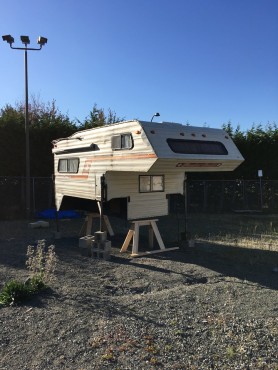Sitting in the Fine Arts quad, waiting for my interviewee to arrive, I watched the confused faces of onlookers walking past the camper van seemingly dropped from the sky out of nowhere in front of the Visual Arts building.
I didn’t blame them — not many of us are used to seeing vehicles in the middle of campus, especially when they’re eight and a half feet tall, weigh about 2400 lbs, and are supported by six metal legs giving it an insect-esque appearance.
And nobody — myself included — is used to seeing a camper van get up and walk away.
Xiao Xue, fifth-year Fine Arts student and creator of the walking camper van, doesn’t think people should be as astounded as they are.
“That was kind of one of the points [of the project],” Xue says. “It’s crazy that people tell me stuff like, ‘I can’t believe that structure walks, that’s crazy’, and then they get in their car . . . that drives 60 miles per hour and you push the pedal and go.” She motions back to the camper. “And this is crazy?”
Xue’s art project is called “Something To Ponder On: A Walking Camper”, and it was built and designed as the final submission for her Visual Arts degree. It’s a striking structure. The camper van is dilapidated, with paint beginning to strip from its 30-year-old sides, and supported by six steel legs.
It walks slowly, three legs moving at a time, and can go either forwards or backwards. For Xue, the structure is an artistic take on technology and waste that forces a viewer to recognize the power of mechanical engineering and ask questions about how society uses and disposes of technology.
“We make things that can only live if they’re dependent, and we force them to be that way,” says Xue. “You make accessories only for one object, and when it doesn’t have that one object it doesn’t have a meaning anymore. It’s just there, being waste.”
An acquaintance of Xue gifted her the van after he had spent months failing to sell it. Upon acquiring it, Xue was struck by how sad it looked; on her website she compares it to a pet without an owner, or an amputated limb. She didn’t know what a final piece would look like, but she knew she could make something out of the vehicle.
Once the idea came to her, Xue started making wooden models (or maquettes) and drawing up designs, calling up metal shops and engineers regarding the feasibility of such a project. But even with dozens of people who were generous enough to help Xue with the piece, challenges in acquiring the knowledge and technical language to plan the project meant there were times that Xue felt she’d bitten off more than she could chew.
“If I knew how much trouble was in this I might not have gone [for it],” Xue says, “but back then I’m like, ‘oh this is doable!’”
“When you’re ignorant about something,” she laughs, “you’re very confident.”
But now, as she talks me through the machinery operating the camper’s legs, Xue speaks with the vocabulary and ease of a lifelong mechanic. The secret to her success?
“It was just a huge amount of Google,” she laughs. “Just Google every single day. I had 30 tabs open on my computer all the time.”
After hours of googling (and even more hours more of welding the metal herself), Xue is proud of the finished piece. After hiring a crane to drop the 2400 lb structure outside the Visual Arts building, she’s watched as students and visitors alike stare at the camper van, answering their questions about it or and helping them make the camper walk back and forth.
Even if people don’t connect with the piece’s message of dependency and waste and instead just enjoy it for the mechanical marvel that is, Xue doesn’t mind.
“I don’t need them to understand everything, and that’s quite an impossible thing as well,” Xue says. “They can take it however they want.”
Right as she says this, a UVic electrician stops by the camper. He looks at Xue inquisitively and asks her what the camper is doing. She demonstrates the walk, yanking the power cable out of the way of its stuttering limbs.
“Where did you come up with this?” he asks.
Xue looks at me and laughs. She duly begins another demonstration, and I can’t help but be amazed as the camper begins its slow and steady back and forward movements. Not that I’m the only one — both myself and the electrician are equally astounded at the structure.
Thankfully, Xue understands.
“When you finally look it, you think, ‘that looks fragile’,” Xue says. “You don’t think it could actually work. But it does.”










